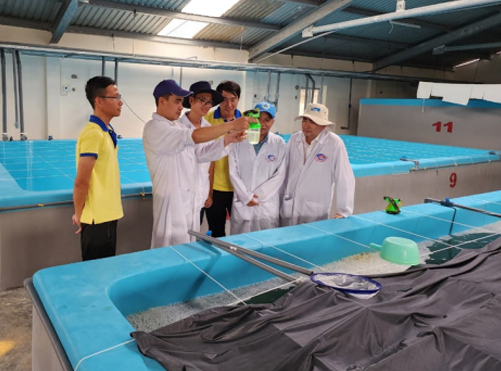ProBio Media in Aquaculture Analysis
Biological Filtration using Nano-Enhanced Media
ProBio Media is a porous nano-media that improves water quality and results in higher fish yields. This media has been used in both fresh and saline aquaculture systems to support healthier seafood environments. Benefits depend upon operating parameters but usually include many of the following:
- Lower ammonia levels and elimination of ammonia spikes that damage fish health
- Visibly clearer water from proper algae control
- Lower mortality rate and lower infection rates among fish
- Less food waste and a drop in feed conversion ratios
- Reduction of organic waste, leading to less frequent water changes
- Provides a fast ROI for the farmer
Specifics
The exceptionally high surface area (12,000 m2 per kg) of ProBio Media supports the formation of large bacteria colonies in water ecosystems. Beneficial bacteria eliminate ammonia, pathogens, and other organics to maintain a healthy aquaculture environment. ProBio Media is a bacteria multiplier that will continuously add bacteria to the water to support much higher concentrations compared to other products. ProBio Media supports multiple bacteria colonization including aerobic bacteria for nitrification on outer oxygenated surfaces and anaerobic bacteria for denitrification on the inner oxygen-depleted surfaces. Typical ammonia removal is 1200 to 4000 grams NH3/m3-day and nitrate removal of 1400 to 6000 grams NO3/m3-day.


Case Studies
Probio media application is simple in design and passive in operation. It has been used extensively in aquaculture with admirable results and performance:
MONODON (BLACK TIGER) HATCHERY TRIAL AT MINH PHU HATCHERY, 2023. NAUPLIUS UNTIL PL 12:
This trial was performed by Minh Phu, the largest and most experienced shrimp aquaculture company in Vietnam. In a head-to-head test between two groups, using five tanks for each group, one utilized PBM and the other used Vietnamese best-practice probiotics in the water, with all other conditions remaining the same. The results showed PBM outperformed the other group with a 15% increase in yield and a 92% survival rate.


| Test Group using ProBio Media | Control Vietnamese best-practice probiotics | |
| Yield | +15% | +0% |
| Survival Rate | 92% | 80% |
| pH | Steady at 7.8 | pH rose with ammonia increase |
NHA TRANG UNIVERSITY - GROW OUT
- Testing was completed using three groups of 4 m3 tanks. The first group used ProBio Media, the second used a dosed industry-standard Vietnamese probiotic (BioFloc), and the third served as a control group with no bacteria addition.
- Nitrogen cycling in the ProBio group was much quicker and was below 1 mg/L NH3 while other groups experienced spikes as high as 5 mg/l NH3
- The tanks with ProBio Media had an 11.3% weight increase.



| ProBio Media | ‘BioFloc’ Best Practice |
Ammonia (max value) | 1 mg/L | 5 mg/l |
Weight per shrimp | 37.7 g (26.5 shrimp/kg) | 33.9 g (29.5 shrimp/kg) |
Other characteristics | Improved appearance and taste |
|
Vannamei (White Leg) 'Nursery' Trial at Minh Phu Loc An (January 2024):
- In this recent trial ProBio Media was tested against a best practice control in 4 replicate tanks
- Using PBM resulted in 27% increase in weight, 35.3% increase in final biomass and 6.8% reduction in food conversion ratio (FCR).
- Toxic nitrite was never detected in PBM treated tanks while in the control the NO2- concentration rose to 8 mg/L.
- Similarly total ammoniacal nitrogen (TAN) rose to nearly 3 mg/L in the control treatment while in PBM treated tanks TAN stayed below 1.4 mg/L.
| ProBio Media | Best Practice Control |
Weight | 0.28 g (+27.3%) | 0.22 g |
Final biomass | 99.3 kg (+35.3%) | 73.4 kg |
FCR | 1.01 (-6.8%) | 1.09 |
Nitrite max conc. | Not Detected | 8 mg/L |
TAN max conc. | 1.4 mg/L (-52%) | 2.9 mg/L |
ECUADOR SHRIMP GROW OUT-2016
- Testing was completed in 35 ponds - 15 used ProBio Media and 20 served as a control, each with a stocking density between 100-150 PL/m3. Total volume of each treatment ~115K m3.
- The same probiotic mix was used in both the test group and the control. The only difference was the ProBio media.
- The ProBio media achieved 15% higher yield in 30% less time, for harvest value increase of 50% per annum
TOP VIETNAMESE MONODON HATCHERY
Hatchery Field Observation, 2023-Nauplius until PL 12:
In a head-to-head test between two groups, one utilized PBM and the other used Vietnamese best-practice probiotics in the water, with all other conditions remaining the same. The results showed PBM outperformed the other group with a 15% increase in yield and a 92% survival rate in a replicated trial using five tanks for each group.

| Test Group using ProBio Media | Control using the same Probiotics | |
|---|---|---|
| Final No. of Shrimp Harvested | 73,000m3 63% Yield | 55,000m3 48% Yield |
| Total Biomass of shrimp harvested | 1,100 Kg per Ha | 820 Kg per Ha |
| Grow Out Period | 60 days (6 per year) | 90 days (4 per year) |
| Harvest value per Ha per annum (@10$/kg) | $66,000 per Ha | $33,000 per Ha |
ADDITIONAL CASE STUDIES AND RESULTS
- Shrimp Hatchery – Two identical 50,000 L grow-out tanks were tested for 20 days. ProBio Media was added to one of them while the other served as a control.
- Tank with ProBio Media: pH of 7.8 maintained with no ammonia spikes – Yield was 99% and larvae weighed 20% more
- Control Tank: pH increased to 10.8, water replacement was required to lower pH, with ammonia spikes – Yield was 79%
- Tilapia Aquaculture – A 6-month study was completed in a facility in Alabama (U.S.) in a 38,000 L Tilapia tank.
- Results showed that the use of ProBio Media resulted in reduced fish death before maturity from 13% to 2%, a food waste drop of 24%, improvement in aeration efficiency due to quicker breakdown of organic wastes, a reduction in ammonia spikes, and healthier looking fish when sold to live fish markets.
- Large-Scale Shrimp Farm – Testing was done in five lined ponds (50 x 50 x 1.5 m – 0.2 hectare). Data was gathered regularly to compare 2 ponds with ProBio Media media with 3 control ponds.
- Results showed that ponds using ProBio Media harvested 14% more shrimp and required 6% less food.
- Test ponds remained clear throughout the growing cycle, while one of the control ponds was brown in color.
- No algae formed in the test ponds while it regularly grew in control ponds.
- Post-harvest, ponds were drained and liners had much less organic sediment compared to control ponds.
CERAMICHLOR
In addition to ProBio Media, we developed a new patented nano-ceramic disinfectant that replaces existing disinfection methods and reduces levels of vibrio and other pathogenic bacteria on contact. In Ceramichlor, our porous ceramic material is infused with our proprietary blend of antimicrobial nano-compounds. These antimicrobial compounds kill bacteria faster and more safely than chlorine or bromine without any hazardous disinfection byproducts such as chloramines or metal-halides.
CERAMICHLOR IS NON-CHEMICAL AND SAFE FOR SHRIMP/FISH!

Ceramichlor eliminates disease vectors and can be used in recirculating systems or ponds to disinfect waterborne pathogens from the environment and to meet regulations for release of fecal indicator bacteria from spent water. Along with aquaculture, recreational pools can also benefit from use of Ceramichlor, yielding highly purified, crystal clear water to swim and bathe in.
CERAMICHLOR AND PROBIO MEDIA CAN BE USED IN COMBINATION:
Using ceramichlor to eliminate pathogens from inflow and recirculating water removes unwanted pathogens from the water. Concurrently, using Probio Media fixes heterotrophic and ammonia oxidizing bacteria as biofilm. The combination of the two leads to lower ammonia and vibrio levels.
THIS LEADS TO:
- Faster growth of shrimp/fish – more kilos per cycle
- Higher yields per water volume – by as much as +20%
- Higher hatchery yields, improved larvae/fingerling growth & quality
- Reduces FCR and saves on feed
- Fewer and much less intense ammonia spikes
- Lower sludge production
- Less required water changes
- More effective oxygenation and less energy costs for aeration
Conclusion
There is a clear correlation between the use of ProBio Media and increased ROI for seafood farms. These case studies show significant increase in yields and product quality. The improvement in water quality reduces fish mortality and feed conversion ratio while increasing the hygiene of the product and lowering energy consumption.
